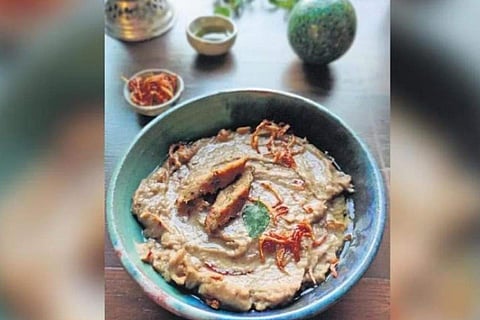
- LIFESTYLE
- FASHION
- FOOD
- ENTERTAINMENT
- EVENTS
- CULTURE
- VIDEOS
- WEB STORIES
- GALLERIES
- GADGETS
- CAR & BIKE
- SOCIETY
- TRAVEL
- NORTH EAST
- INDULGE CONNECT

It is said that to truly appreciate the beauty of Kashmir, one must visit it during the chillaikalan. Never mind that these six weeks—that begin from December 20 and last till January-end—are also the harshest days of winter. A 40-day period when people all over the valley sport the thick, unisex woolen embroidered tunic called a pheran; each insulated by those ingenious portable heaters called kanger to keep the chill at bay. But chillaikalan—that’s followed by the 20-day-long chillaikhurd and the subsequent, 10-day phase of chillai bacha, which marks the end of the cold season—is also the time when one more winter special comes to the fore.
Known multifariously as harees, hareesa or harissa (not to be confused with the Tunisian spice paste of the same name), it is a pounded meat (lean, de-boned lamb), grain (mostly rice) and aromatic spice-redolent delicacy that’s cooked overnight and served only for breakfast. As early as 4 am, one can find people gathered outside stalls called harissa-wans waiting for the aroma of the delicacy to waft out. It is always served with crisp naan, bits of which are torn apart and used to scoop up morsels of the comfort food into eager mouths. This is best chased with the salted, pink-hued tea called noon chai, which is a bit of an acquired taste.
Also read: Exploring India's snacking legacy
Food critic and writer, the Srinagar-based Marryam Reshii, says, “During biting cold winters combined with electricity outages, harissa is the bright spot in Kashmir. Traditionally made and sold only in the old city of Srinagar, it is sheep meat on the bone cooked for several hours in an enclosed vessel that is insulated by a clever invention of the harissa-gors as the cooks-cum-sellers are called. Garlic, salt, cardamom, cinnamon, cloves and black pepper are a fraction of the appeal.” Thanks to culinary travellers, the dish has now evolved into an all-year-round delicacy. For instance, Chai Jaai tea room that sits on The Bund along Srinagar’s Residency Road serves a close-to-traditional style of harissa 365 days a year.
Given its heartiness, the dish is only sold in winter to fuel the masses with its unctuous pounded meat and rice parts, which are always in a 1:1 ratio. These are cooked overnight in a copper pot called maath in Kashmiri, which is buried in the earth, with a chamber for firewood below. With times changing, it’s not uncommon for many harissa-wans to use gas-propelled fires these days. “Spices like cinnamon, fennel seeds and the de rigueur cardamom—the flavour of Kashmir—are abundantly coaxed into the porridge-like mix, which is topped with a ladle of hot mustard oil that is set alight before being splashed over the contents of the maath,” explains Jasleen Marwah, a Kashmiri Sikh home chef-turned-restauranteur, who runs Folk in Mumbai. This multi-regional Indian cuisine restaurant is one of the few places in the city where one can try out this winter specialty all year round.
At first bite, it is easy to see how parallels can be drawn, comparing harissa with similar meat porridge-esque dishes like haleem and khichda. Both are popular dishes across the Indian subcontinent and both use lentils—something that doesn’t go into harissa. While haleem is cooked until the meat blends with the lentils, in khichda, chunks of meat remain whole as cubes.
Interestingly, all three have their underpinnings in the Arabian dish known as harees. The first written recipe of harees dates back to the 10th century, when Arab scribe Abu Muhammad al-Muzaffar ibn Sayyar compiled a cookbook called Kitab Al-Tabikh.
Farmer and food curator Afshan Rashid, who runs an organic farm called Baag Manzuk in Pulwama near Srinagar, says that the difference is that instead of rice, as in a harissa, a harees has meat that is cooked with wheat and uses a different selection of spices. “The origins of harissa date back to the time when the Silk Route was in use. This is another vestige of a legacy that Kashmir has inherited via its trade route,” says Rashid.
Agreeing to similarities with haleem, celebrity chef and entrepreneur, the Kolkata-based Sabyasachi Gorai, says, “The consistency of both the dishes is paste-like. Also, the origins for both lie in the Azerbaijan region. What I, however, find fascinating about harissa is that it is mostly cooked by men. In fact, there is a saying in Kashmiri, which means that ‘the dish is ready to be eaten when you grow a stubble’, meaning that it takes one the entire night to cook, and is served only at dawn. The glutinous texture might put off the less-adventurous epicure, but it is what makes this dish a class apart. Once you’ve tasted it, you’ll keep coming back to it.”
Marryam Reshii, Food critic and writer